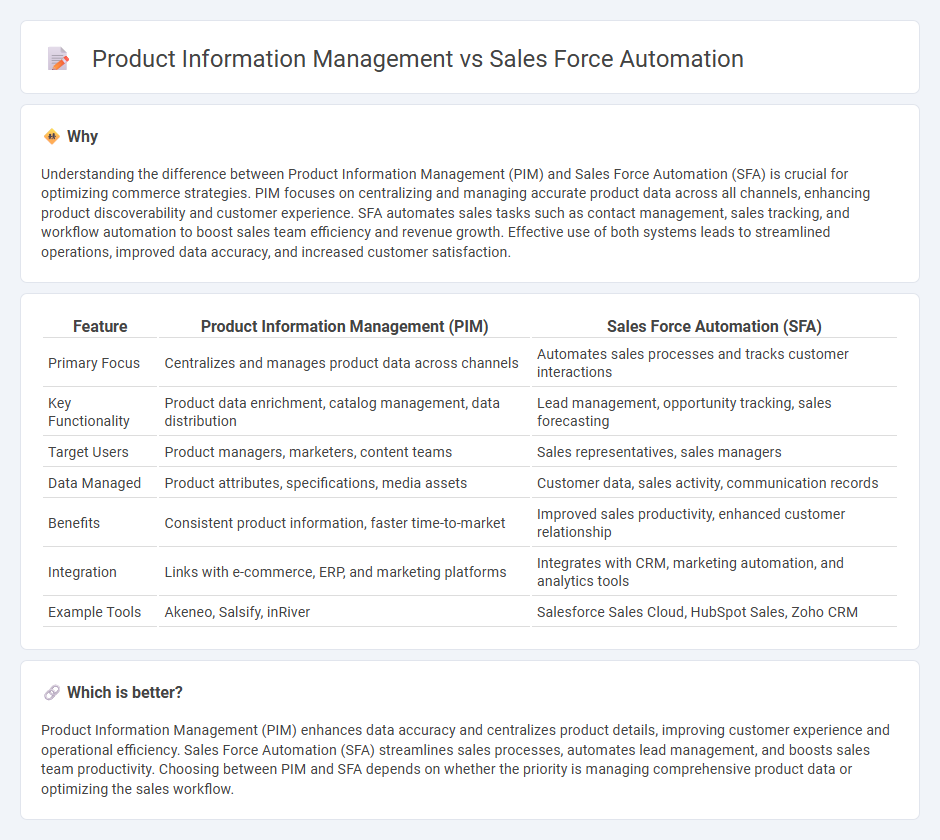
Product Information Management (PIM) centralizes and organizes detailed product data to ensure accuracy and consistency across all sales channels, improving product visibility and customer experience. Sales Force Automation (SFA) focuses on automating sales tasks such as lead management, forecasting, and customer communications to enhance sales team productivity and accelerate revenue growth. Explore the key differences and benefits of PIM and SFA to optimize your commerce strategy.
Why it is important
Understanding the difference between Product Information Management (PIM) and Sales Force Automation (SFA) is crucial for optimizing commerce strategies. PIM focuses on centralizing and managing accurate product data across all channels, enhancing product discoverability and customer experience. SFA automates sales tasks such as contact management, sales tracking, and workflow automation to boost sales team efficiency and revenue growth. Effective use of both systems leads to streamlined operations, improved data accuracy, and increased customer satisfaction.
Comparison Table
| Feature | Product Information Management (PIM) | Sales Force Automation (SFA) |
|---|---|---|
| Primary Focus | Centralizes and manages product data across channels | Automates sales processes and tracks customer interactions |
| Key Functionality | Product data enrichment, catalog management, data distribution | Lead management, opportunity tracking, sales forecasting |
| Target Users | Product managers, marketers, content teams | Sales representatives, sales managers |
| Data Managed | Product attributes, specifications, media assets | Customer data, sales activity, communication records |
| Benefits | Consistent product information, faster time-to-market | Improved sales productivity, enhanced customer relationship |
| Integration | Links with e-commerce, ERP, and marketing platforms | Integrates with CRM, marketing automation, and analytics tools |
| Example Tools | Akeneo, Salsify, inRiver | Salesforce Sales Cloud, HubSpot Sales, Zoho CRM |
Which is better?
Product Information Management (PIM) enhances data accuracy and centralizes product details, improving customer experience and operational efficiency. Sales Force Automation (SFA) streamlines sales processes, automates lead management, and boosts sales team productivity. Choosing between PIM and SFA depends on whether the priority is managing comprehensive product data or optimizing the sales workflow.
Connection
Product Information Management (PIM) centralizes and organizes product data, ensuring accuracy and consistency across all sales channels. Sales Force Automation (SFA) leverages this well-structured product information to streamline sales processes, improve customer interactions, and enhance order accuracy. The integration of PIM with SFA enables sales teams to access real-time, reliable product details, driving higher efficiency and increased revenue.
Key Terms
CRM (Customer Relationship Management)
Sales force automation (SFA) streamlines sales processes by automating tasks such as lead management, sales forecasting, and customer follow-ups, enhancing CRM efficiency through improved sales pipeline visibility. Product information management (PIM) centralizes and manages product data, ensuring accurate, consistent product information across CRM systems to better support sales and marketing activities. Explore in-depth how integrating SFA and PIM within CRM platforms maximizes customer insights and drives stronger sales performance.
SKU (Stock Keeping Unit)
Sales force automation (SFA) streamlines the sales process by managing customer interactions, tracking leads, and automating order entries, enabling efficient SKU tracking in the sales pipeline. Product information management (PIM) centralizes and manages detailed SKU data, including descriptions, pricing, and inventory levels, ensuring consistent and accurate product information across all channels. Explore how integrating SFA and PIM systems enhances SKU management efficiency and boosts overall business performance.
Lead Tracking
Sales force automation (SFA) enhances lead tracking by automating interactions, managing customer data, and streamlining follow-ups to boost sales efficiency. Product Information Management (PIM) primarily organizes and enriches product data but lacks specialized tools for direct lead tracking and sales process automation. Explore how integrating SFA and PIM systems can optimize your lead management and increase conversion rates.
Source and External Links
What is Salesforce Automation (SFA): A Comprehensive Definition - Sales force automation (SFA) automates and simplifies sales processes by managing leads, contacts, and opportunities to help sales teams focus on engaging prospects and closing deals more efficiently.
What is Sales Force Automation Software (SFA)? | Salesforce US - Sales force automation software streamlines tedious tasks like lead prioritization, data entry, quoting, and performance tracking, boosting sales team productivity and enabling focus on high-value selling activities.
NetSuite Sales Force Automation - NetSuite's SFA capabilities unify sales processes from opportunity and quote management to forecasting and order management, providing real-time insights that enhance collaboration, efficiency, and sales performance across departments.
 dowidth.com
dowidth.com